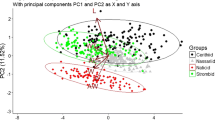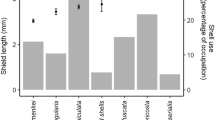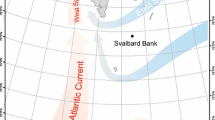Abstract
In ecology, interaction networks allow the investigation of how interactions among species affect community structure and functioning. The structure of interaction networks can be nested and/or modular. Ecologically, the nested structure minimizes competition and increases the number of coexisting species, creating high diversity, while the modular structure occurs when there are non-overlapping groups of highly interacting consumer-resource species. Despite the importance of gastropod shells to hermit crabs, currently, few studies explored the structure of hermit crabs communities through a resource-usage perspective. Therefore, network analyses appear as an important tool to unveil how the use of empty shell as a resource rules hermit crabs communities through competition among species and rules hermit crabs populations through competition among distinct ontogenetic groups. This study investigated the resource usage pattern of empty gastropod shells by distinct ontogenetic stages of the hermit crab Calcinus tibicen from two different locations, using a network approach and the “Shell Adequacy Index” (SAI) analysis. The present results show that the interaction network between ontogenetic groups and gastropod shells was non-nested and modular and the SAI reflected the differences between males and ovigerous females in both locations, regarding shell size adequacy. We suggest that the modular structure may be a result of resource partitioning, which, in turn, is favored in habitats with a high degree of heterogeneity. The modular network structure may indicate habitat heterogeneity and resource partitioning. Future studies including other hermit crab species from the same areas should help determine how shells are partitioned interspecifically.



Similar content being viewed by others
Availability of data and material
The data that support the findings of this study are available upon reasonable request from the corresponding author.
References
Abrams PA (1988) Sexual difference in resource use in hermit crabs; consequences and causes. In: Chelazzi G, Vannini M (eds) Behavioral adaptation to intertidal life. Plenum Press, New York, pp 283–296
Alcaraz G, Kruesi K (2009) The role of previous shell occupancy in the wild on laboratory shell choice by the hermit crab Calcinus californiensis. Mar Freshw Behav Physiol 42:55–62. https://doi.org/10.1080/10236240802663564
Almeida-Neto M, Ulrich W (2011) A straightforward computational approach for measuring nestedness using quantitative matrices. Environ Model Softw 26:173–178. https://doi.org/10.1016/j.envsoft.2010.08.003
Angel JE (2000) Effects of shell fit on the biology of the hermit crab Pagurus longicarpus (Say). J Exp Mar Bio Ecol 243:169–184
Argüelles A, Álvarez F, Alcaraz G (2009) Shell architecture and its relation to shell occupation by the hermit crab Clibanarius antillensis under different wave action conditions. Sci Mar 73:717–723. https://doi.org/10.3989/scimar.2009.73n4717
Asakura A (1995) Sexual differences in life history and resource utilization by the hermit crab. Ecology 76:2295–2313. https://doi.org/10.2307/1941703
Atkinson WD, Newbury SF (1984) The adaptations of the rough winkle, Littorina rudis, to desiccation and to dislodgement by wind and waves. J Anim Ecol 53:93. https://doi.org/10.2307/4344
Augustyn WJ, Anderson B, Ellis AG (2016) Experimental evidence for fundamental, and not realized, niche partitioning in a plant-herbivore community interaction network. J Anim Ecol 85:994–1003. https://doi.org/10.1111/1365-2656.12536
Ayres-Peres L, Quadros AF, Mantelatto FL (2012) Comparative analysis of shell occupation by two Southern populations of the hermit crab Loxopagurus loxochelis (Decapoda, Diogenidae). Braz J Oceanogr 60:299–310
Ballarin CS, Hachuy-Filho L, Sanz-Veiga PA, Amorim FW (2019) The resource-mediated modular structure of a non-symbiotic ant–plant mutualism. Ecol Entomol 45:121–129. https://doi.org/10.1111/een.12780
Bertini G, Fransozo A (2000) Patterns of shell utilization in Petrochirus diogenes (Decapoda, Anomura, Diogenidae) in the Ubatuba Region, São Paulo, Brazil. J Crustac Biol 20:468–473. https://doi.org/10.1163/20021975-99990061
Bertness MD (1980) Shell preference and utilization patterns in littoral hermit crabs of the bay of Panama. J Exp Mar Bio Ecol 48:1–16. https://doi.org/10.1016/0022-0981(80)90002-7
Bertness MD (1981) Predation, physical stress, and the organization of a tropical rocky intertidal hermit crab community. Ecology 62:411–425
Bertness MD (1982) Shell preference and utilization patterns in littoral hermit crabs of the Bay of Panama: an interoceanic comparison. J Exp Mar Bio Ecol 64:155–187. https://doi.org/10.1016/0022-0981(80)90002-7
Blüthgen N, Menzel F, Blüthgen N (2006) Measuring specialization in species interaction networks. BMC Ecol 6:1–12. https://doi.org/10.1186/1472-6785-6-9
Boulding EG (1990) Are the opposing selection pressures on exposed and protected shores sufficient to maintain genetic differentiation between gastropod populations with high intermigration rates? Hydrobiologia 193:41–52. https://doi.org/10.1007/BF00028065
Boulding EG, Holst M, Pilon V (1999) Changes in selection on gastropod shell size and thickness with wave- exposure on northeastern pacific shores. J Exp Mar Bio Ecol 232:217–239. https://doi.org/10.1016/S0022-0981(98)00117-8
Brooks WR (1988) The influence of the location and abundance of the sea anemone Calliactis tricolor (Le Sueur) in protecting hermit crabs from octopus predators. J Exp Mar Bio Ecol 116:15–21. https://doi.org/10.1016/0022-0981(88)90242-0
Chesson P (2000) Mechanisms of maintenance of species diversity. Annu Rev Ecol Syst 31:343–366. https://doi.org/10.1146/annurev.ecolsys.31.1.343
Coelho PA, de Ramos M (1972) A constituição e a distribuição da fauna de decápodos do litoral leste da América do Sul entre as latitudes de 5 N e 39 S. Trab Ocean da Univ Fed Pernambuco 13:133–236
Conover MR (1978) The importance of various shell characteristics to the shell-selection behavior of hermit crabs. J Exp Mar Bio Ecol 32:131–142. https://doi.org/10.1016/0022-0981(78)90111-9
de Melo GAS (1999) Manual de identificação dos Crustacea Decapoda do litoral brasilero: anomura, thalassinidea, palinuridea. Astacidea, Plêiade
De Souza ECF, Turra A, Leite FPP, Gorman D (2015) Intra-specific competition drives variation in the fundamental and realized niches of the hermit crab, Pagurus criniticornis. Bull Mar Sci 91:343–361. https://doi.org/10.5343/bms.2015.1005
Dominciano LCC, Mantelatto FLM (2004) The influence of shell species and size on the shell selection pattern of Paguristes tortugae (Decapoda, Diogenidae) from Anchieta Island (Ubatuba, Brazil). Iheringia Ser Zool 91:425–428. https://doi.org/10.1590/S0073-47212004000400012
Dormann CF, Strauss R (2014) A method for detecting modules in quantitative bipartite networks. Methods Ecol Evol 5:90–98. https://doi.org/10.1111/2041-210X.12139
Dormann C, Gruber B, Fründ J (2008) Introducing the bipartite package: analysing ecological networks. Interaction 1:2413793
Dormann CF, Frund J, Bluthgen N, Gruber B (2009) Indices, graphs and null models: analyzing bipartite ecological networks. Open Ecol J 2:7–24. https://doi.org/10.2174/1874213000902010007
Dupont YL, Trøjelsgaard K, Olesen JM (2011) Scaling down from species to individuals: a flower-visitation network between individual honeybees and thistle plants. Oikos 120:170–177. https://doi.org/10.1111/j.1600-0706.2010.18699.x
Fotheringham N (1976) Population Consequences of shell utilization by hermit crabs. Ecology 57:570–578
Frameschi IF, de Andrade LS, Alencar CERD et al (2013) Shell occupation by the South Atlantic endemic hermit crab Loxopagurus loxochelis (Moreira, 1901) (Anomura: diogenidae). Nauplius 21:137–149. https://doi.org/10.1590/s0104-64972013000200002
Frameschi IF, Andrade LS, Fransozo V et al (2015) Shell occupation by the hermit crab Dardanus insignis (Decapoda, Diogenidae) from the north Coast of São Paulo state, Brazil. Braz J Biol 75:35–44. https://doi.org/10.1590/1519-6984.00614
Fransozo A, Garcia RB, Mantelatto FLM (2003) Morphometry and sexual maturity of the tropical hermit crab Calcinus tibicen (Crustacea, Anomura) from Brazil. J Nat Hist 37(3):297–304
Garcia RB, Mantelatto FLM (2001) Shell selection by the tropical hermit crab Calcinus tibicen (Herbst, 1791) (anomura, diogenidae) from Southern Brazil. J Exp Mar Bio Ecol 265:1–14. https://doi.org/10.1016/S0022-0981(01)00321-5
Giraldes BW, Coelho Filho PA, Coelho PA (2012) Composition and spatial distribution of subtidal decapoda on the “Reef Coast”, northeastern Brazil, evaluated through a low-impact visual census technique. Nauplius 20:187–201. https://doi.org/10.1590/s0104-64972012000200010
Guimarães PR, Sazima C, Dos Reis SF, Sazima I (2007) The nested structure of marine cleaning symbiosis: Is it like flowers and bees? Biol Lett 3:51–54. https://doi.org/10.1098/rsbl.2006.0562
Hazlett BA (1981) The behavioral ecology of hermit crabs. Annu Rev Ecol Syst 12:1–22
Hazlett BA (1989) Mating success of male hermit crabs in shell generalist and shell specialist species. Behav Ecol Sociobiol 25:119–128. https://doi.org/10.1007/BF00302928
Hazlett BA, Baron LC (1989) Influence of shells on mating behavior in the hermit crab Calcinus tibicen. Behav Ecol Sociobiol 24:369–376. https://doi.org/10.1007/BF00293264
Heller J (1976) The effects of exposure and predation on the shell of two British winkles. J Zool 179:201–213. https://doi.org/10.1111/j.1469-7998.1976.tb02291.x
Horn HS (1966) Measurement of “ Overlap “ in comparative ecological studies. Am Nat 100:419–424
Ings TC, Montoya JM, Bascompte J et al (2009) Ecological networks: beyond food webs. J Anim Ecol 78:253–269. https://doi.org/10.1111/j.1365-2656.2008.01460.x
Koch EBA, Dáttilo W, Camarota F, Vasconcelos HL (2018) From species to individuals: Does the variation in ant: Plant networks scale result in structural and functional changes? Popul Ecol 60:309–318. https://doi.org/10.1007/s10144-018-0634-5
Kuris AM, Brody MS (1976) Use of principal components analysis to describe the snail shell resource for hermit crabs. J Exp Mar Bio Ecol 22:69–77. https://doi.org/10.1016/0022-0981(76)90109-X
Leite FPP, Turra A, Gandolfi SM (1998) Hermit crabs (Crustacea: decapoda: Anomura), gastropod shells and environmental structure: their relationship in Southeastern Brazil. J Nat Hist 32:1599–1608. https://doi.org/10.1080/00222939800771131
Lewinsohn TM, Inácio Prado P, Jordano P et al (2006) Structure in plant-animal interaction assemblages. Oikos 113:174–184. https://doi.org/10.1111/j.0030-1299.2006.14583.x
Lima DJM, Alves DFR, Cobo VJ (2018) Composition, density, and shell use of hermit crabs (Crustacea: paguroidea) from subtidal boulder fields in southeastern Brazil. Lat Am J Aquat Res 46:72–82. https://doi.org/10.3856/vol46-issue1-fulltext-9
Mantelatto FL, de Meireles AL (2004) The importance of shell occupation and shell availability in the hermit crab Pagurus brevidactylus (Stimpson, 1859) (Paguridae) population from the Southern Atlantic. Bull Mar Sci 75:27–35
Mantelatto FLM, Garcia RB (2000) Shell utilization pattern of the hermit crab Calcinus tibicen (Diogenidae) from southern Brazil. J Crustac Biol 20:460–467
Mantelatto FLM, Garcia RB (2002) Hermit crab fauna from the infralittoral zone of Anchieta Island (Ubatuba, Brazil). In: Escobar-Briones E, Alvarez F (eds) Modern approaches to the study of Crustacea. Kluwer Academic/Plenum, Amsterdam, pp 137–143
Mantelatto FL, Faria FCR, Iossi CL, Biagi R (2007) Population and reproductive features of the western Atlantic hermit crab Pagurus criniticornis (Anomura, Paguridae) from Anchieta Island, southeastern Brazil. Iheringia Ser Zool 97:314–320. https://doi.org/10.1590/s0073-47212007000300016
Mantelatto FL, Fernandes-Góes LC, Fantucci MZ et al (2010) A comparative study of population traits between two South American populations of the striped-legged hermit crab Clibanarius vittatus. Acta Oecol 36:10–15. https://doi.org/10.1016/j.actao.2009.09.003
Mantelatto FL, Faria FCR, Biagi R, Meireles AL (2016) An integrative approach-using field and laboratory data to characterize shell utilization and selection pattern by the hermit crab Pagurus criniticornis (Paguridae) from Anchieta Island, Brazil. Nauplius 24:1–10. https://doi.org/10.1590/2358-2936e2016011
Maruyama PK, Vizentin-Bugoni J, Oliveira GM et al (2014) Morphological and spatio-temporal mismatches shape a neotropical savanna plant-hummingbird network. Biotropica 46:740–747. https://doi.org/10.1111/btp.12170
McLean RB (1974) Direct shell acquisition by hermit crabs from gastropods. Experientia 30:206–208
Mello MAR, Marquitti FMD, Guimarães PR et al (2011) The missing part of seed dispersal networks: structure and robustness of bat-fruit interactions. PLoS ONE 6:1–10. https://doi.org/10.1371/journal.pone.0017395
Mitchell KA (1976) Shell selection in the hermit crab Pagurus bernhardus. Mar Biol 35:335–343. https://doi.org/10.1007/BF00386644
Neil SJ, Elwood RW (1985) Behavioural modifications during egg-brooding in the hermit crab, Pagurus bernhardus L. J Exp Mar Bio Ecol 94:99–114. https://doi.org/10.1016/0022-0981(85)90052-8
Olesen JM, Dupont YL, O’Gorman E et al (2010) From Broadstone to Zackenberg. Space, time and hierarchies in ecological networks. Adv Ecol Res 42:1–69. https://doi.org/10.1016/B978-0-12-381363-3.00001-0
Pandey V, Thiruchitrambalam G, Satyam K (2018) Habitat heterogeneity determines structural properties of intertidal gastropod assemblages in a pristine tropical island ecosystem. Indian J Geo-Mar Sci 47:846–853
Patefield WM (1981) Algorithm AS 159: an efficient method of generating random R × C tables with given row and column totals. J R Stat Soc Ser C Appl Stat 30:91–97
Peres PAS, Ferreira AP, Leite FPP (2018) Expanding the “shell exchange market” hypothesis for clustering behavior in intertidal hermit crabs: mating and tide as proximate factors. J Exp Mar Bio Ecol 500:100–104. https://doi.org/10.1016/j.jembe.2017.12.019
Pinheiro RBP, Felix GMF, Dormann CF, Mello MAR (2019) A new model explaining the origin of different topologies in interaction networks. Ecology 100:1–10. https://doi.org/10.1002/ecy.2796
Reese ES (1962) Shell selecion behaviour of hermit crabs. Anim Behav 21:78–126
Reese ES (1963) The behavioral mechanisms underlying shell selection by hermit crabs. Behaviour 21:78–126
Ribeiro FB, Matthews-Cascon H, Mantelatto FL, Bezerra LEA (2015) Shell occupation and ectosymbionts of two hermit crab species in the South Atlantic: a comparative analysis. J Mar Biol Assoc United Kingdom 96:1535–1545. https://doi.org/10.1017/S0025315415001836
Rios EC (1994) Seashells of Brazil. Fundação cidade do Rio Grande, Instituto Acqua, Museo Oceanográfico de Rio Grande, Universidade de Rio Grande
Rodrigues ACM, Martinelli-Lemos JM (2016) Gastropod shell utilisation pattern by the hermit crab Clibanarius symmetricus (Anomura: diogenidae) in an Equatorial Amazon estuary. J Nat Hist 50:2657–2671. https://doi.org/10.1080/00222933.2016.1210688
Rodrigues G, Ballarin C, Fransozo A, Amorim F (2020) Structural patterns of a coastal hermit crab-gastropod shell interaction network: new insights from a unique relationship. Mar Ecol Prog Ser 640:117–126. https://doi.org/10.3354/meps13288
Sant’Anna BS, Zangrande CM, Reigada ALD, Pinheiro MAA (2006) Shell utilization pattern of the hermit crab Clibanarius vittatus (Crustacea, Anomura) in an estuary at São Vicente, state of São Paulo, Brazil. Iheringia Ser Zool 96:261–266. https://doi.org/10.1590/s0073-47212006000200018
Sant’Anna BS, Da Cruz Dominciano LC, Buozi SF, Turra A (2012) Is shell partitioning between the hermit crabs Pagurus brevidactylus and Pagurus criniticornis explained by interference and/or exploitation competition? Mar Biol Res 8:662–669. https://doi.org/10.1080/17451000.2011.653371
Scully EP (1979) The effects of gastropod shell availability and habitat characteristics on shell utilization by the intertidal hermit crab Pagurus longicarpus Say. J Exp Mar Bio Ecol 37:139–152. https://doi.org/10.1016/0022-0981(79)90091-1
Shiffman DS, Kaufman L, Heithaus M, Hammerschlag N (2019) Intraspecific differences in relative isotopic niche area and overlap of co-occurring sharks. Aquat Ecol. https://doi.org/10.1007/s10452-019-09685-5
Shipley ON, Gallagher AJ, Shiffman DS et al (2019) Diverse resource-use strategies in a large-bodied marine predator guild: evidence from differential use of resource subsidies and intraspecific isotopic variation. Mar Ecol Prog Ser 623:71–83. https://doi.org/10.3354/meps12982
Silva AR, Galli GM, Stanski G et al (2019) Shell occupation as a limiting factor for Pagurus brevidactylus (Stimpson, 1859) in the Marine State Park of Laje de Santos, Brazil. Invertebr Reprod Dev 63:1–10. https://doi.org/10.1080/07924259.2018.1513087
Silva AR, Rodrigues GFB, Lima D et al (2020) The hermit crab-shell relationship through the lens of interaction networks: the use of network metrics and species role across communities. Aust Ecol. https://doi.org/10.1111/aec.12903
Steibl S, Laforsch C (2020) Shell resource partitioning as a mechanism of coexistence in two co-occurring terrestrial hermit crab species. BMC Ecol 20:1–9. https://doi.org/10.1186/s12898-019-0268-2
Team RC (2019) R: a language and environment for statistical computing, version 3.0. 2. Vienna, Austria: R Foundation for Statistical Computing; 2013
Teoh HW, Chong VC (2014) Shell use and partitioning of two sympatric species of hermit crabs on a tropical mudflat. J Sea Res 86:13–22. https://doi.org/10.1016/j.seares.2013.10.008
Teoh HW, Ali Syed Hussein M, Chong VC (2014) Influence of habitat heterogeneity on the assemblages and shell use of hermit crabs (Anomura: diogenidae). Zool Stud 53:1–9. https://doi.org/10.1186/s40555-014-0067-6
Thompson JN (2002) Plant–animal interactions: future directions. In: Herrera CM, Pellmyr O (eds) Plant–animal interactions: an evolutionary approach, pp 236–247
Thompson JN (2006) Mutualistic webs of species. Science 312:372–373. https://doi.org/10.1126/science.1126904
Tricarico E, Bertocchi S, Brusconi S et al (2009) Shell recruitment in the Mediterranean hermit crab Clibanarius erythropus. J Exp Mar Bio Ecol 381:42–46. https://doi.org/10.1016/j.jembe.2009.09.001
Trussell GC, Johnson AS, Rudolph SG, Gilfillan ES (1993) Resistance to dislodgement: habitat and size-specific differences in morphology and tenacity in an intertidal snail. Mar Ecol Prog Ser 100:135–144. https://doi.org/10.3354/meps100135
Tur C, Vigalondo B, Trøjelsgaard K et al (2014) Downscaling pollen: transport networks to the level of individuals. J Anim Ecol 83:306–317. https://doi.org/10.1111/1365-2656.12130
Turra A, Leite FPP (2003) The molding hypothesis: linking shell use with hermit crab growth, morphology, and shell-species selection. Mar Ecol Prog Ser 265:155–163. https://doi.org/10.3354/meps265155
Vale VF, Moraes SASN, Brito VLG et al (2017) Shell use by sympatric hermit crab species in a seasonally open coastal lagoon in Northeastern Brazil. Mar Ecol 38:1–14. https://doi.org/10.1111/maec.12451
Vance RR (1972) The role of shell adequacy in behavioral interactions involving hermit crabs. Ecology 53:1075–1083
Vázquez DP, Aizen MA (2003) Null model analyses of specialization in plant-pollinator interactions. Ecology 84:2493–2501. https://doi.org/10.1890/02-0587
Yamada S (1972) The role of wave impact and desiccation on the distribution of Littorina sitkana Philippi, 1845. Veliger 15:129–132
Acknowledgements
We would like to thank “Universidade Estadual do Sudoeste da Bahia (UESB), Vitória da Conquista campus” for their technical and logistic support for this research. We also thank the undergraduate students Jaqueline de Oliveira, Anne F. Alves and Suzane Moreira for their field and laboratory assistance. The sampling of specimens conducted herein was performed in compliance with current applicable Brazilian state and federal laws concerning wild animals.
Funding
The State University of the Southeastern of Bahia (UESB) has supported the present study.
Author information
Authors and Affiliations
Contributions
All authors contributed to the study conception and design. MPS, GFBR, VR and MLN-F carried out the material preparation, data collection and analysis. MPS and GFBR elaborated the first draft of the manuscript. After that, all authors commented and suggested alterations or adaptations on previous versions of the manuscript. All authors have read and approved the final version of the manuscript.
Corresponding author
Ethics declarations
Conflict of interest
The authors declare that they have no conflict of interest.
Additional information
Publisher's Note
Springer Nature remains neutral with regard to jurisdictional claims in published maps and institutional affiliations.
Handling Editor: Télesphore Sime-Ngando.
Supplementary information
Below is the link to the electronic supplementary material.
Rights and permissions
About this article
Cite this article
Santos, M.P., Rodrigues, G.F.B., Negreiros-Fransozo, M.L. et al. Resource partitioning and adequacy among ontogenetic groups in a hermit crab and gastropod shell network. Aquat Ecol 55, 253–264 (2021). https://doi.org/10.1007/s10452-020-09827-0
Received:
Accepted:
Published:
Issue Date:
DOI: https://doi.org/10.1007/s10452-020-09827-0




